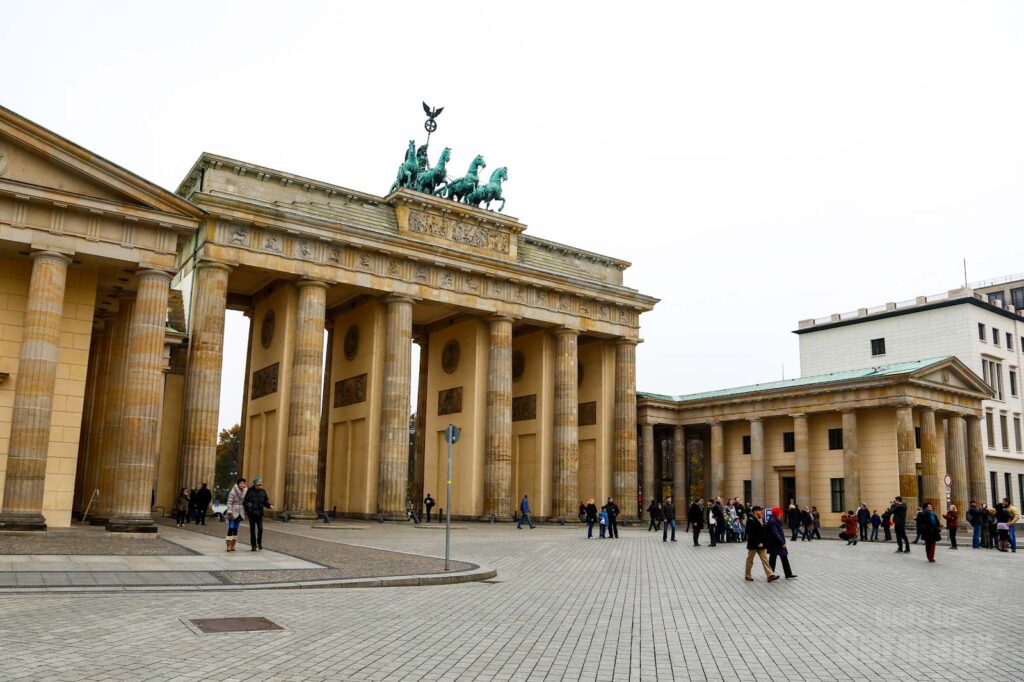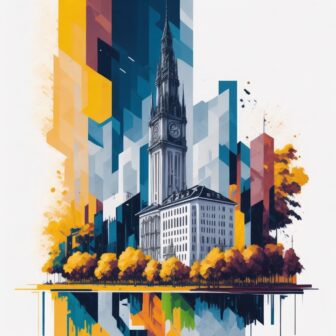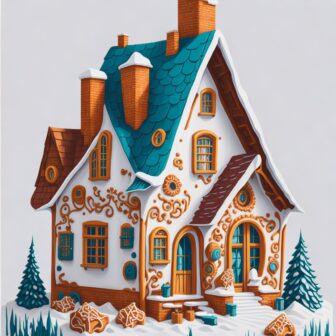25 Famous Landmarks in Germany You Must Visit (2023)
I have put together for you which sights in Germany are definitely worth a visit. Whether it’s a city trip, a short vacation with the family or a romantic vacation for couples, you will find your destination on this list of famous landmarks in Germany. Here you will find the right sight for every occasion as well as the biggest attractions in Germany.
Neuschwanstein Castle
Neuschwanstein Castle is internationally one of the most famous sights in Germany and one of the most popular sights in Bavaria.
Every year more than 1.5 million tourists from all over the world come to see the fairytale castle.
Its location in the foothills of the Alps also makes it a popular travel destination in Germany.
It was built from 1869 on behalf of the Bavarian King Ludwig II. For him, Neuschwanstein represented the perfect ideal of a medieval knight’s castle.
These include a neo-Gothic style bedroom, a living room with original furniture and the richly decorated throne room.
Neuschwanstein Castle is just as suitable for a trip with the family as it is for a holiday as a couple. Up to 6000 people visit the castle every day.
Brandenburg Gate

The Brandenburg Gate is the top attraction in Berlin.
There is hardly a postcard from the capital without an image of the photogenic gate.
The Brandenburg Gate was built between 1789 and 1793 as the end of the Dorotheenstadt boulevard.
Today, the classical building also attracts so many visitors because it is inextricably linked to German history.
During the division of Berlin, it stood directly on the border between East and West Berlin.
A few decades ago, crossing it seemed like a dream that could never be fulfilled.
The Quadriga on the roof of the Brandenburg Gate was taken to Paris as booty by Napoleon in 1806. In 1814 she returned to Berlin.
Marienplatz Munich
The central square in Munich is not only the starting point of the Munich pedestrian zone, you will also find many sights of the Bavarian capital there.
A sight in itself is the New Town Hall.
It was built from 1867 to 1909 and belongs to the neo-Gothic style.
Due to the adjacent buildings and the many events that regularly take place at Marienplatz, the central square is a popular sight in Munich and throughout Germany.
If you want to start a day of shopping through the metropolis, Marienplatz is also the right place to start.
RELATED:
Best Hotels with Direct Access to Thermal Baths in Germany
Best Themed Hotels in Germany
Best Tree House Hotels in Germany
Best Castle Hotels in Germany
Best Biohotels and Nature Hotels in Germany
Miniature Wonderland Hamburg
In Hamburg’s Speicherstadt you can experience the world in miniature.
The Miniatur Wunderland Hamburg, founded in 2000, was Germany’s top tourist attraction among foreign tourists in 2017, according to the German National Tourist Board.
Where else can you marvel at so many attractions in the world in such a small space?
You can take a look at the Harz mountains or at the fictional small town of Knufflingen and its airport.
A lot of technology was installed so that the miniature world is not too static.
Cars are driving, ships and model railways are in motion. There are also many light and sound effects.
The miniature wonderland Hamburg also takes you to America, Scandinavia, Hamburg, the Alps, Switzerland and Italy.
Dresden Frauenkirche
Where only a few foundation walls stood after the Second World War, the rebuilt Dresden Frauenkirche has shone in new splendor since 2005.
Restoration work began in 1994.
Today, the Dresden Frauenkirche is considered an official symbol of reconciliation due to its history.
During the rebuilding, all the stones that were still to be used were meticulously cataloged and placed in the rebuilt church.
It is one of the most popular sights in Dresden and enjoys a reputation as a special travel destination throughout Germany.
RELATED:
Best Hotels in Dresden
Best Places to Visit in Dresden
Blumeninsel Mainau
One of the most beautiful German sights is the flower island of Mainau.
From 1951 onwards, Lennart Bernadotte, the son of the Swedish King Wilhelm, transformed Mainau into the Flower Island we know today and opened it up to visitors.
He had left the line of succession to the Swedish throne and devoted himself entirely to the Mainau Flower Island project.
Bernadotte also had the castle on the island of Mainau renovated and made it his residence.
Today you can walk through wonderful park landscapes - flowering beds and shrubs as far as the eye can see.
Around a million tulips and other spring flowers bloom on Mainau in spring.
In summer you can enjoy over 11,000 dahlias.
Imperial Cathedral of Speyer
Speyer Cathedral is the largest preserved Romanesque church in the world and is one of the most beautiful sights in our country.
In 1981 UNESCO declared the cathedral a World Heritage Site. The sight cannot be overlooked on a walk through the old town of Speyer.
From the viewing platform at a height of about 60 m you have a great view over Speyer and the region.
On the way to the church tower it is worth taking a look at the Kaisersaal. It is above the entrance portal of the cathedral.
In the hall there are nine monumental frescoes by the painter Johann Baptist Schraudolph, which used to be on the walls of the transept.
When the cathedral was renovated, they were dismantled and stored.
Since 2012 you can marvel at them in the Kaisersaal.
Kaiserburg Nürnberg
Another highlight of the travel destinations in Germany is the Imperial Castle in Nuremberg.
The castle is around 1000 years old and was once the imperial residence and burgrave seat of the Hohenzollern noble family.
It was almost completely destroyed in World War II, but was almost completely rebuilt afterwards.
Today it is a popular tourist destination.
At the castle you will find a museum that sheds light on the history of the castle and its inhabitants.
The tour of the historic rooms takes you through the knight’s hall, double chapel and bower, where the Imperial Castle Museum is located today.
The castle garden of the Kaiserburg is also particularly popular.
There has been a garden on the castle complex since 1425, but it has changed again and again over the centuries.
Moseltal
You can hike through vineyards or ride a bike here. A boat trip on the Moselle is particularly idyllic.
With a view of the vineyards and the romantic villages and towns along the water, your short break will be unique.
Numerous grape varieties are grown in the Mosel-Saar-Ruwer wine-growing region.
Countless opportunities for a wine tasting are available to you at winegrowers and in wine taverns throughout the Moselle valley.
Düsseldorfer Altstadt
The longest bar in the world - as it is also called - the old town of Düsseldorf in beautiful North Rhine-Westphalia.
In the small streets you will not only find extravagant parties and music events, but of course also the famous Altbier from Düsseldorf.
In addition to the liquid attraction, a visit to the art collection of North Rhine-Westphalia, the market square and the oldest building in the old town is also worthwhile in Düsseldorf’s old town: the Basilica of St. Lambertus.
Insider Tip:
Some old breweries not only open their gastronomic doors, but also let you look behind the scenes of the art of brewing.
Anna Amalia Library Weimar
In the 18th century, the Anna Amalia Library in Weimar made a massive contribution to strengthening free thinking in literature.
Wolfgang von Goethe, Friedrich Schiller and Gottfried Herder and many other well-known poets and thinkers stayed in Weimar at the end of the 18th and beginning of the 19th century.
Thanks to his tolerant ruler, Duke Carl August, and his mother Anna Amalia, the scholars of that time were able to develop freely and work at court.
The library is best known for its oval Rococo hall, which extends over three floors.
Even non-readers are drawn to the library for this reason.
A fire on September 2, 2004 destroyed around 50,000 volumes and 35 paintings from the 16th to 18th centuries.
28,000 books were saved, including a Luther Bible from 1534.
RELATED:
Old town of Rothenburg ob der Tauber
The old town of Rothenburg ob der Tauber is undoubtedly one of the most beautiful and popular sights in Germany.
The medieval streets of the old town have been preserved in almost their original condition.
Cozy squares, winding streets and lush parks take you back to the Middle Ages.
The old town is still surrounded by a city wall with six city gates.
Nothing stands in the way of romantic walks for two.
Even if Rothenburg ob der Tauber is only a small town, it awaits you with a wealth of churches, museums and other historical sites.
Leipziger Zoo
With its wealth of species, the Leipzig Zoo is one of the most beautiful in Germany.
According to the British Sheridan Zoo Ranking, Leipzig Zoo has been number two among the best zoos in Europe and number one among the best zoos in Germany for several years.
Since 2011 you can experience animals and plants from Asia, Africa and South America in a huge tropical hall.
You can travel through Gondwana land by boat or explore the facility on foot.
Two restaurants with a view of the tropics ensure a holiday atmosphere.
Insider Tip:
From the park in Leipzig’s Rosental you can look at the giraffe enclosure in Leipzig Zoo and see the meter-high animals.
Wattenmeer - Wadden Sea
For nature lovers, the Wadden Sea of the North Sea is a real highlight.
The influence of the tides can be clearly felt on many stretches of coast.
When the water has receded, you can go for wonderful walks there or be driven through the mudflats in a carriage.
The Wadden Sea is also a resting place for migratory birds, which stop here on their way south.
You can also find the famous lugworm in the Wadden Sea.
In the area of the Wadden Sea on the North Sea, around 9,000 square kilometers of seabed are exposed at low tide.
Cologne cathedral
This German sight is world-famous and, like many other buildings in Germany, is a UNESCO World Heritage Site.
Cologne Cathedral is a true masterpiece of Gothic architecture.
Inside, the church impresses with its size as well as from the outside.
The nave is 144 meters long and the vault is over 43 meters high.
You reach the viewing platform on the 157.22 meter high south tower after 533 steps.
The shrine of the Three Kings in the chancel dates from the 13th century and is the largest medieval gold work in Europe.
Cologne Cathedral took an incredible 632 years to build. The works were started in 1248 and finished in 1880.
Sanssouci Palace
Potsdam, the capital of Brandenburg, has a large number of palaces and other stately buildings to offer. But none of the buildings is as magnificent as Sanssouci Palace.
Prussian King Frederick II had the magnificent residence built in 1745. A large staircase that leads up through the terraced garden to the castle is decisive for the look.
Vines and olives were planted on the terraces. Frederick II’s tomb is on the top terrace.
In addition to Sanssouci Palace, you can also visit the New Palace, the Orangery Palace or the Belvedere on the Pfingstberg in the Sanssouci Palace Park.
The New Palace was the favorite palace of the last Prussian King Wilhelm II.
RELATED:
Heidelberger Schloss
The Heidelberg Castle is one of the most famous ruins in Germany and is also popular with international tourists.
You can see exhibitions about the history of the castle in the preserved part of the castle or go for a walk in the spacious gardens.
A special highlight is the annual castle illuminations in summer, followed by fireworks.
From the so-called Philosophenweg you have a great view of the castle ruins of Heidelberg.
This runs on the other side of the Neckar and bears his name because poets and thinkers used to let their thoughts wander here.
Heidelberg Castle was overrun by soldiers from the Sun King Louis XIV in 1689 and partially blown up by French pioneers in 1693.
RELATED
Best Places to Visit in Heidelberg
Best Hotels in Heidelberg
Europa-Park Rust
Europa-Park Rust is a popular family attraction in southern Germany.
Unlike many other amusement parks, it is open for a few weeks even in winter.
On 95 hectares you can experience endless fun.
You can even stay in 5 themed hotels in the park.
Over 100 spectacular rides and breathtaking shows make your holiday to this well-known German attraction a special experience.
The park was originally planned as an exhibition area for the products offered by the Mack founding family.
They dealt with the development and production of amusement park attractions.
Europa-Park wins awards without end: Best amusement park in the world, hotelier of the year, best attraction.
Golden Hall in Augsburg
The Golden Hall was built between 1615 and 1620.
It was originally planned as a meeting room for the Reichstag.
However, the Thirty Years’ War and the relocation of the Reichstag to Regensburg meant that the hall was never used for its intended purpose.
We have the people of Augsburg to thank for the fact that the Golden Hall on the first floor of Augsburg Town Hall now shines again in its old glory.
By the early 1980s there was nothing left of the former gem.
During the Second World War, the town hall and the hall were completely destroyed.
Only then did they begin to rebuild it true to the original.
Today it is one of the most beautiful town hall halls in Germany and is a real tourist magnet.
2.6 kg of gold leaf were processed in the Golden Hall. Sounds like little? An area of 1 square meter can be carved from 2 grams of gold leaf.
Altstadt and Stiftskirche Quedlinburg
The city of Quedlinburg is particularly impressive with its historic old town and cobbled streets.
It rightly belongs to the UNSECO World Heritage Site and is a special attraction in Germany.
The town hall from the Renaissance period stands on the market square, and the Romanesque collegiate church with the cathedral treasury is on the Schlossberg.
Other beautiful places in Quedlinburg are the Münzberg with the monastery church of St. Marien, as well as the church of St. Petri with the abbey garden and the Brühl Park.
They are also part of the UNESCO World Heritage.
You will find around 2,000 half-timbered houses from around eight centuries in the city. Quedlinburg’s old town is one of the largest area monuments in Germany.
Erfurt Cathedral
The church ensemble of Erfurt Cathedral and the Severikirche determines the Erfurt cityscape and, together with the old town and the unique Krämerbrücke, is one of the most popular German sights.
A first church is said to have stood on the site of today’s cathedral as early as 752. The building was first mentioned in 1117.
Today you can see the stained glass windows in the church from the Middle Ages and the interior of the choir, which has largely been preserved in its original state.
The high altar has also been preserved.
It was made between 1697 and 1707.
The ringing of the church includes a total of 13 bells. One of them, the Gloriosa, is the largest free-swinging medieval church bell in the world.
Lübeck Holsten Gate
The late Gothic Holstentor is the landmark of the Hanseatic city of Lübeck.
It used to be one of Lübeck’s city gates and secured the rich Hanseatic city from the outside.
Today, many tourists come to Lübeck every year.
There is a museum inside the Holsten Gate. This represents the history of the Lübeck Hanseatic League.
In addition to the impressive Holstentor, the adjacent old town with its many Gothic brick buildings is a travel destination worth seeing in Germany.
In 1863, the Lübeck citizenship voted on whether to keep or demolish the Holstentor. The politicians voted to keep the landmark by just one vote.
Nürburgring
A special attraction in Germany is the Nürburgring in the Eifel.
The race track built between 1925 and 1927 is named after the nearby Nürburg.
The racetrack, more precisely the Nordschleife, is known today above all for the fact that you can do your laps here in your private car.
If that’s too tricky for you, you can also take a racing taxi across the Ring.
Amateurs from Germany and other European countries come to the Nürburgring with their converted cars perfectly tuned for the fast pace.
Also around the race track, which extends to a total of around 28 kilometers, you are completely attuned to the speed lovers. Countless pubs and restaurants have settled here.
In addition, there are many places where you can go directly to the race track and watch the spectacle from a safe distance.
Extremely demanding track conditions such as sharp curves and steep gradients earned the Nürburgring the nickname “Green Hell”.
Eltz Castle
The pinnacle of a knight’s fortress and “the most beautiful castle in Europe,” Eltz Castle is described as “a fairy tale in stone.”
The Eltz Castle is unique. It was unaffected by war. From the time of construction to the present, the same family has owned and maintained it. There are still many of the original eight-century furnishings in place.
Along with gorgeous courtly artifacts made of gold and silver, it also has simple armor sets, swords, and halberds. It stands tall on a big rock buried deep within a valley.
It is surrounded by the tranquil Eltz Forest, a nature preserve with a wealth of hiking paths and open spaces for sports and enjoyment for people of all ages.
Black Forest National Park
There aren’t many places in Baden-Württemberg where social development has been and continues to be so intertwined with the natural world as the Black Forest.
Together with the local population, the state government seeks to preserve and develop the Black Forest in all of its distinctiveness and connection to nature. A national park contributes significantly to this and serves as a distinctive marketing factor for the area.
For the entire state of Baden-Württemberg, the creation of the Black Forest National Park represents a significant step toward upholding our obligation to conserve the environment and endangered animals. Additionally, it makes a significant contribution to people’s ability to experience nature and its workings.






